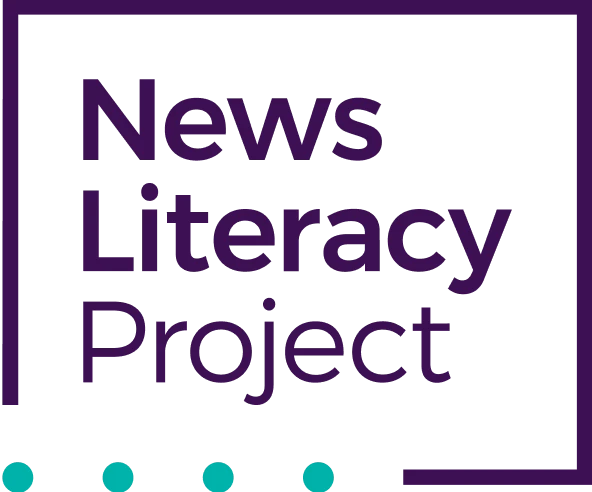The Sift: AI videos of you | Polarization online
Note: The Sift will not be published on next Monday’s federal holiday (Oct. 13). We’ll return on Monday, Oct. 20.
In this issue
AI videos of you | Polarization online | RumorGuard slides
Daily Do Now slides
Don't miss this week's classroom-ready resource.
Top picks
Here are the latest news literacy topics and tips on how to integrate them into your classroom.
Artificial intelligence technology can now generate videos with anyone’s likeness.
1. OpenAI launches new social app for sharing fakes
OpenAI’s new social media app Sora (named after its video generator) allows anyone to generate and share realistic-looking videos of themselves. It's a major development in AI technology, which has rapidly evolved in just the last few months.
- Real people, fake video: To produce AI videos of themselves, Sora users are encouraged to add their likeness to the app. The videos can be nearly anything they imagine, whether that’s flying with friends (who also share their likeness) or walking down the street with a giraffe. Sora can even make convincing-looking videos in the style of security or body-camera footage.
- Potential challenges: More AI-generated videos of real people doing fake things online is almost certain to some guardrails to what the app will and won’t produce, some users have found ways to evade them.
- Practice skepticism: As AI videos become increasingly indistinguishable from authentic footage, experts now say to assume that every video online from an unknown source could be AI-generated until proven otherwise.
- Watermark: For now, Sora-generated videos include a watermark.
💬 Discuss:
- If you encounter a video online that you think might be AI-generated, what steps would you take to verify its authenticity?
- Should videos generated by AI technology have labels or watermarks? Why or why not?
- Which would be worse: A world in which everyone believes every video they see on social media is real, or a world in which everyone believes every video is fake (and nothing is real)? Why?
⭐ NLP Resources:
- Infographic: “6 things to know about AI”
- Lesson plan: “AI or not?”
- “Introduction to Algorithms” (Checkology® virtual classroom)
🔗 Related:
- “Americans have mixed feelings about AI summaries in search results” (Pew Research Center).
- “Next Time You Consult an A.I. Chatbot, Remember One Thing” (The New York Times).
2. AI creates illusion of trusted voices
India Today journalist Pooja Shali was “completely shocked” when videos of her news broadcasts — doctored by AI to make it look like she endorsed a mobile stock trading app she had never even heard of — spread online.
- Journalists are targets: Scammers are exploiting broadcast journalists’ recognizability and credibility to produce AI-doctored (or “deepfake”) videos of them saying things they never said.
- After the fake endorsement featuring Shali went viral, India Today published a video debunking the fake endorsement.
- Doctors, too: Scammers aren’t just targeting journalists — they’re using deepfakes of famous doctors (link warning: sexual health content), along with fabricated videos of entirely fake doctors, to push dubious medical advice and products.
💬 Discuss:
- How might AI-generated videos of doctors and journalists impact trust in the medical field or in news media?
- How should social media companies deal with AI-doctored videos of real experts? What about AI-generated videos of fake experts? Should they allow them, label them or ban them? Why?
💡 Idea: Use the “Generative AI” slide in Week 5 of the Daily Do Now resource to further explore this topic.
⭐ NLP Resources:
- Quiz: “AI-generated news or not?”
- “Be Health Informed” (Checkology)
🔗 Related:
- “Deepfakes and misinformation — how to tell the facts from the fiction” (Financial Times).
- “UK health blogger ‘adversely influenced’ daughter’s cancer treatment, coroner says” (Radio New Zealand).
- “Buffalo mother targeted in AI voice scam using son’s voice to demand ransom” (WKBW).
3. Ethnic news outlets counter disinfo
An analysis of 45 Asian American, Black, Indigenous and Latino news outlets by the International Center for Journalists found that these newsrooms play a pivotal role in countering the spread of misinformation. Other major findings include:
- Community engagement: Some ethnic news outlets monitored digital spaces like WhatsApp groups and engaged with users in a timely way — providing context with news reporting that addressed specific rumors.
- Journalistic objectivity: Some of the journalists interviewed believe that partisan impartiality is an effective way to combat disinformation and build trust, while others expressed concerns that traditional practices related to objectivity can result in “bothsidesism” that legitimizes falsehoods and harmful narratives.
- Trust in mainstream press: When it comes to legacy news sources, the study found that people of color were less likely to distrust the mainstream press (32%) than white participants of the study (44%).
💬 Discuss:
- In what ways might ethnic and Indigenous news outlets be uniquely well-positioned to counter misinformation?
- What factors influence the public’s trust in mainstream news sources? What portion of the public’s distrust do you think is due to media practices and what they cover? What portion is due to the hostility and attacks on the press in public discussions?
⭐ NLP Resources:
- “Harm & Distrust” (Checkology)
🔗 Related:
These classroom-ready slide decks provide a comprehensive walk-through on how to debunk false rumors.
Are refs being sidelined for bad calls? False suspension rumors go viral
❌ NO: NFL Commissioner Roger Goodell did not suspend four referees who officiated the game between the Green Bay Packers and the Cleveland Browns on Sept. 21.
✅ YES: This false claim — as well as similar online rumors involving refs for various NFL, college football and major league baseball games — originated with unreliable clickbait pages that target team fan bases.
✅ YES: In early September, the Big 12 Conference suspended an officiating crew after a rules violation marred the outcome of a game between Kansas and Missouri.
⭐ NewsLit takeaway:
Did our favorite team lose a fair competition? Or was it the fault of the refs? We are far more susceptible to misinformation when it is a falsehood that we want to be true. View these Google Slides for tips on spotting the red (or yellow?) flags of confirmation bias.
Image of suspected Michigan church shooter wearing political shirt is genuine
✅ YES: A photograph shows Thomas Jacob Sanford, the suspect in a Sept. 28 shooting that killed five and injured others, wearing a “Trump 2020: Make Liberals Cry Again” shirt.
❌ NO: This photograph was not altered to add the political graphic.
✅ YES: Altering images to add (or in this case remove) political logos on people’s shirts is a common way to spread misinformation.
⭐ NewsLit takeaway:
Tragedies like a mass shooting are often used by purveyors of misinformation to spread inflammatory falsehoods about motives and other details. View these Google Slides for tips on how to spot these politically divisive claims.

➕ A new poll shows that American voters see polarization as the country’s second biggest problem after the economy. Experts point to social media as a cause, where “rage bait” drives engagement.
➕ Can you tell the difference between legitimate local news organizations and “pink slime” sites masquerading as news? These guiding questions can help you determine which outlets are legitimate.
➕ “She” never sleeps or ages. AI-generated actress Tilly Norwood has arrived, and real Hollywood stars are unimpressed.
➕ “The chances of AI completely taking over Hollywood are small,” says the reassuring voice of a New Jersey fourth grader in a podcast submission that won NPR’s Student Podcast Challenge.
➕ Most Americans (75%) say they never get news from AI chatbots, according to the Pew Research Center. But younger adults, who are more likely to use chatbots, also are more likely to say the AI tools give them inaccurate news.
➕ The Free Press founder Bari Weiss is the new editor-in-chief of CBS News. The network’s parent company explains the change as a way to bring more balance.
➕ Journalists in the Philippines, Indonesia and Hong Kong say press freedoms are eroding in their countries. And across the Asia-Pacific region, journalists are being detained at higher rates — led by China, Afghanistan, Vietnam and Myanmar.
Feedback: How do you like this newsletter?
Thanks for reading!
Your weekly issue of The Sift is created by Susan Minichiello, Dan Evon, Peter Adams, Hannah Covington and Pamela Brunskill. It is edited by Lourdes Venard and Mary Kane.
You’ll find teachable moments from our previous issues in the archives. Send your suggestions and success stories to [email protected].
Did someone forward you this newsletter? Subscribe to receive this newsletter in your inbox every Monday.
Check out NLP's Checkology virtual classroom, where students learn how to navigate today’s information landscape by developing news literacy skills.













